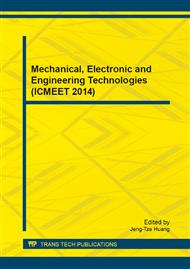[1]
Ledeczi A., Volgyesi P., and Maroti M. Multiple simultaneous acoustic source localization in urban terrain. IPSN 2005, Fourth International Symposium on Information Processing in Sensor Networks, USA: Nashville, (2005) 491-496.
DOI: 10.1109/ipsn.2005.1440982
Google Scholar
[2]
Branislav K., Prabal Dutta, and Philip. Elapsed time on arrival: a simple and versatile primitive for canonical time sychronization services, International Journal of Ad Hoc and Ubiquitous Computing, 1 (2006) 239-251.
DOI: 10.1504/ijahuc.2006.010505
Google Scholar
[3]
Yedavalli K. and Krishnamachari B. Sequence-based localization in wireless sensor networks, IEEE Transactions on Mobile Computing, 1 (2008) 81-94.
DOI: 10.1109/tmc.2008.4387797
Google Scholar
[4]
Zhu J., Zhao H., and Sun P. G. Equilateral Triangle Localization Algorithm Based on Average RSSI, Journal of Northeastern University, 28 (2007) 1094-1097.
Google Scholar
[5]
Doherty L. Algorithms for position and data recovery in wireless sensor networks, Berkeley: University of California, (2000).
Google Scholar
[6]
Doherty L., Pister KSJ, and Ghaoui L. Convex position estimation in wireless sensor networks, Proceedings IEEE INFOCOM, USA: New York, (2001) 1655-1663.
DOI: 10.1109/infcom.2001.916662
Google Scholar
[7]
Yang B and Scheuing J. Cramer-Rao bound and optimum sensor array for source localization from time differences of arrival, 2005 IEEE International Conference on Acoustics Speech and Signal Processing, USA: New York, (2005) 961-964.
DOI: 10.1109/icassp.2005.1416170
Google Scholar
[8]
Yang B. and Scheuing J. A theoretical analysis of 2D sensor arrays for TDOA based localization, 2006 IEEE International Conference on Acoustics, Speech, and Signal Processing, USA: New York, (2006) 901-904.
DOI: 10.1109/icassp.2006.1661115
Google Scholar
[9]
Merhi Z., Elgamel M., and Bayoumi M. A Lightweight Collaborative Fault Tolerant Target Localization System for Wireless Sensor Networks, IEEE Transactions on Mobile Computing, 4 (2009) 379-381.
DOI: 10.1109/tmc.2009.81
Google Scholar
[10]
Wang F. and Liu J. C. RBS: A reliable broadcast service for large-scale low duty cycled wireless sensor networks, ICC 2008 IEEE International Conference on Communications, USA: New York, (2008) 2416-242.
DOI: 10.1109/icc.2008.459
Google Scholar
[11]
You N. and Cha H. J. Scalable and low cost acoustic source localization for wireless sensor networks, Ubiquitous Intelligence and Computing Third International Conference UIC 2006 Proceedings. German: Berlin (2006) 517-526.
DOI: 10.1007/11833529_53
Google Scholar


